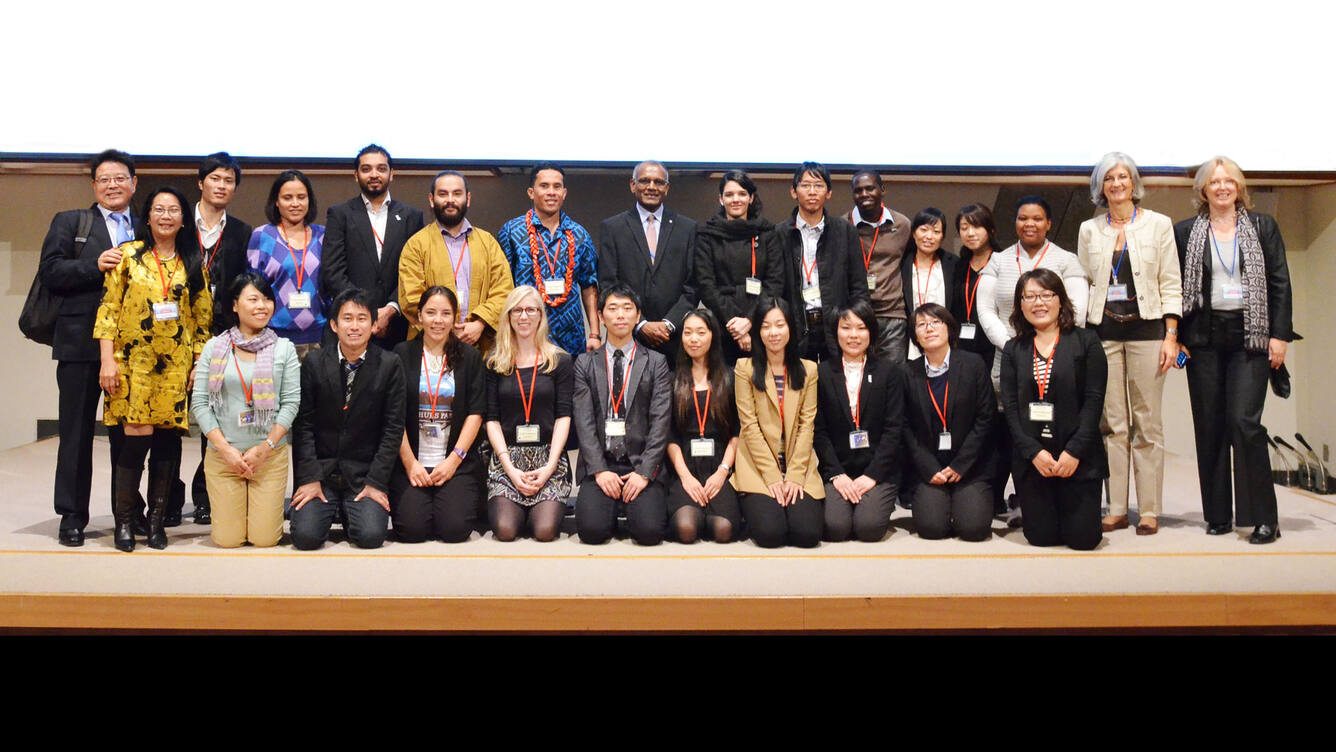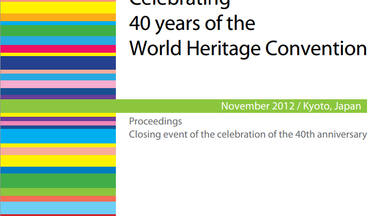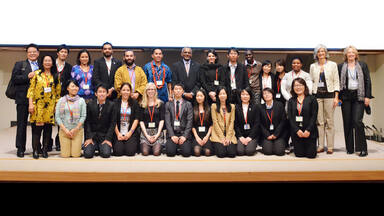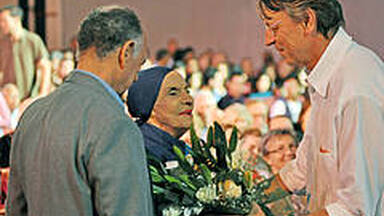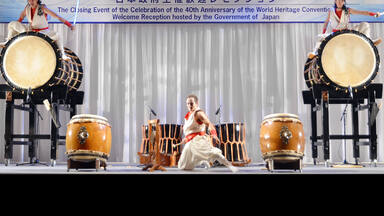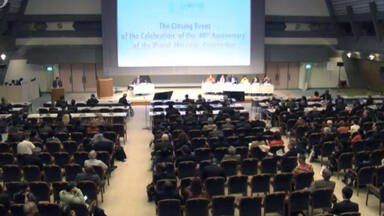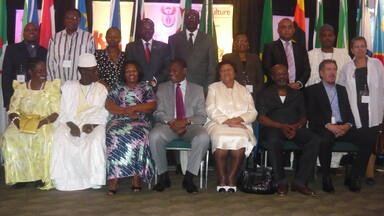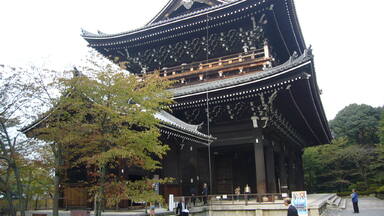World Heritage Convention’s 40th anniversary celebration concludes and launches Kyoto Vision
The Closing Event of the 40thAnniversary of the World Heritage Convention concluded today in Kyoto, Japan, after three days of presentations and lively panel discussions among international World Heritage experts. Held from 6 to 8 November, the occasion was the culmination of a year of celebratory activities around the world, gathering more than 500 international heritage experts from 60 countries.
The event has been the occasion to explore in detail all issues related to the theme of the anniversary year, World Heritage Convention and Sustainable Development: the Role of Local Communities. During the session, the final Kyoto Vision was formulated with the intention to orient the implementation of the World Heritage Convention going forward.
At the press conference following the closure of the event, Kishore Rao, Director of UNESCO’s World Heritage Centre, said,
“This is truly a landmark event. Some of the participants following World Heritage for the past 30 years have called this the most remarkable event of the last decade. A very eclectic group of participants representing diverse groups of interests such as governments, youth, advisory bodies, which span the history of the Convention, were present. We looked at the past, present and future of the Convention and discussed all pertinent issues.” He added, “The organization of the proceedings was exemplary because everyone had an equal voice. It was a unique experience and we had a wonderful outcome in the Kyoto Vision.”
The Kyoto Vision briefly outlines the achievements of the past 40 years of the World Heritage Convention, and the importance of people-centred conservation of World Heritage to contribute to sustainable development and ensure a harmonious relationship between communities and the environment, as the best way to ensure long-term protection of the outstanding universal value of World Heritage sites. The document concludes with a call for action, appealing to the international community to, among other points, ensure “effective involvement of local communities, indigenous peoples, experts and youth” in all aspects of World Heritage conservation, from the nomination of the site to long-term conservation practice.
World Heritage Committee Chair, Ambassador Nishibayashi said, “We all agree that youth have to play a major role in World Heritage protection.” A Youth Statement was presented by the participants of the World Heritage Youth Programme, held in Kyoto from 2 to 5 November, and called "World Heritage: the roles of local communities and youth for the next decade".
In a session dedicated to the World Heritage Convention at present, the panel discussion ‘Our Life and Heritage: Sustainable Development of World Heritage and World Heritage for Sustainable Development’ touched on topics including participatory tourism management at World Heritage sites such as Shiretoko, Japan; the role of World Heritage as a model for sustainability; and sustainable development examples at African World Heritage sites.
The discussion ‘Disaster Prevention, Recovery from Disaster with Communities’, touched on twenty years of implementing the World Heritage Convention at Angkor, Cambodia, the challenges of preserving the cultural heritage landscape of Bamiyan, Afghanistan, and damage reduction and recovery from damage through conserving natural ecosystems.
Community involvement and raising awareness of the principles of the World Heritage Convention were topics in the panel discussion ‘Capacity Building for an Enhanced Implementation of the Convention, Communication Activities for Better Awareness of the Convention and Sustainable Development Connecting Conservation and Communities’. The case of Marrakesh, Morocco, and a consideration of cultural heritage as an important source of life for communities were also touched upon.
The final panel on ‘International Cooperation and Partnerships: Engaging the Civil Society and Public and Private Sector Partnerships in the Implementation of the World Heritage Convention’ covered many aspects of partnerships in support of World Heritage conservation, from partnerships and challenges in Africa, corporate social responsibility, World Heritage Centre private sector partners Panasonic, Jaeger-LeCoultre and Tokyo Broadcasting System presented their support to the World Heritage programmes and awareness-raising activities. Presentations were also made by the African World Heritage Fund, World Tourism Organization, UNDP and the Japanese ICOMOS and IUCN committees.
In his commemorative address, Francesco Bandarin, UNESCO’s Assistant Director General for Culture, focused on the umbrella programme of culture and development, which is key to the post-2015 international development agenda.
The first official recognition of best practice in World Heritage site management was given to the Historic Town of Vigan (Philippines) and a certificate was presented to the Mayor of Vigan, Ms Eva Marie S. Medina. The site was selected among 28 that were nominated for consideration from twenty-three countries.
Vigan’s successful and sustainable management is achieved with relatively limited resources, which makes it adaptable to sites in all countries; the local community is well integrated into many aspects of the sustainable conservation and management of the property; and a multi-faceted approach to the protection of the site has been developed.
Recognizing and rewarding best practice in World Heritage site management on the occasion of the 40th Anniversary of the World Heritage Convention was called for by the World Heritage Committee in 2011. Submissions were reviewed by a selection committee mandated by the UNESCO World Heritage Centre.
A new milestone book published to mark the anniversary was also launched. “World Heritage: Benefits Beyond Borders”, presents a powerful case for the essential contribution of heritage to sustainable development through the study of 26 World Heritage sites from around the world. It is a co-publication of UNESCO and Cambridge University Press, and financed by UNESCO/Japanese Funds-in-Trust for the Preservation of the world’s cultural heritage.
The World Heritage Convention was adopted on 16 November 1972 and is one of the most widely accepted treaties in the world, with 190 States Parties and 962 sites inscribed on the World Heritage List.
The event was co-organized by the UNESCO World Heritage Centre and Japan’s Ministry of Foreign Affairs, Agency for Cultural Affairs, Ministry of the Environment, and Forestry Agency, which cohosted the event.
Media contacts
Gina Doubleday: g.doubleday@unesco.org
